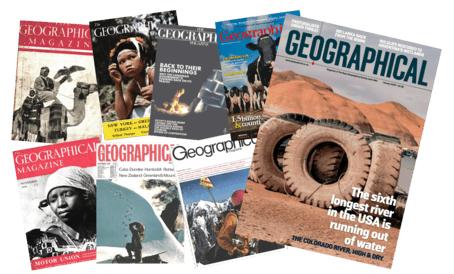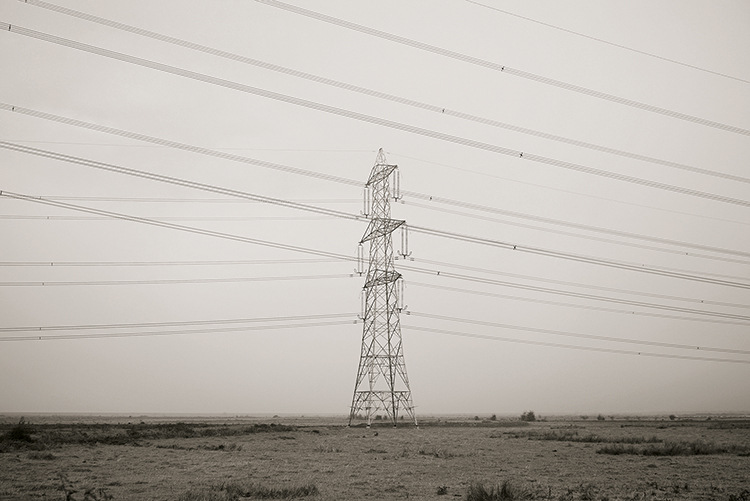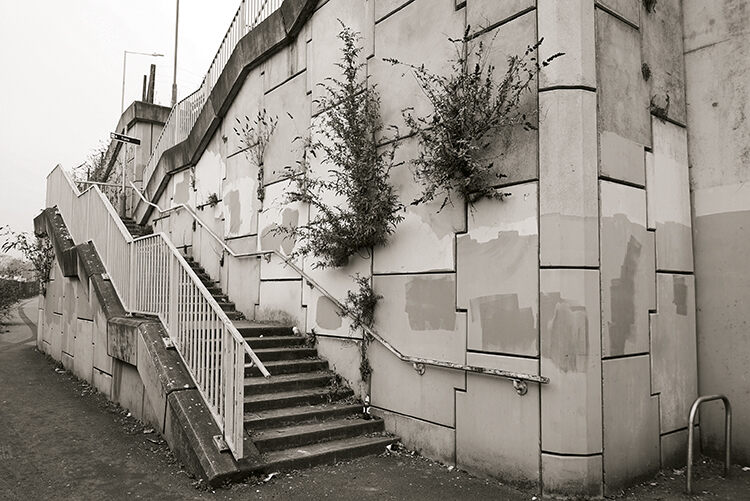Exploring close to home: discovering nature on your suburban doorstep
 A winter’s view in the English countryside. All photographs Alastair Humphreys
A winter’s view in the English countryside. All photographs Alastair Humphreys
Alastair Humphreys, who has rowed the Atlantic, trekked across the Empty Quarter, circumnavigated the globe by bike and run the Marathon Des Sables, decided his next adventure was going to be nearer to home. He got out his local Ordnance Survey map and decided to spend a year exploring as much of the 20 kilometres by 20 kilometres around his home as he could. Each trip involved him randomly selecting one of the map’s 400 grid squares, jumping on his bike and searching for adventure in the modern sprawl that surrounds much of today’s cities. In this extract from Local: A Search For Nearby Nature and Wildness, we join him venturing into some unprepossessing muddy fields next to a motorway.
I hid my bike in a hedge and set out to explore the grid square on foot, keen to see what the world would offer to my imagination today. My voice sounded small as I hummed a song to myself beneath an outsize bridge rumbling with overhead lorries. The solitude I experience in nature is very different from the loneliness that often keeps me company in daily life on this map. It is one of the appeals of swapping Wi-Fi for wellies and going for a wet schlep through muddy, empty landscapes. My outings had recalibrated my preconceptions about how much of my map was covered with concrete and shown that much still lent itself to vigorous, solitary hikes. Though moulded by man, the countryside is not irrevocably wrecked, even in this crowded corner of the country.
I was sheltering beneath the bridge from rain, hoping it would ease. Old habits die hard. Back when I was cycling around the world, I spent a lot of time hiding under bridges from rain or heat. Under today’s bridge, there were piles of nitrous oxide canisters around my feet, shiny and slippery like ball bearings. This gloomy underpass, miles from a town, had been someone’s chosen spot for getting high. I unscrewed my Thermos flask and poured a piping-hot cup of coffee down my throat. That’s my drug of choice these days. Hot black coffee on cold, grey mornings also brings back memories of the open road.
 Wine bottle and drain cover: a modern still life
Wine bottle and drain cover: a modern still life
I gave up waiting for the weather, returned the flask to my bag, pulled up my hood and got going. Away from the motorway, there were no buildings or roads on today’s square, no walls or people. Just a long, muddy path crossing a dozen flat fields marked by hedges.The hedgerows felt empty, until a chirping cloud of long-tailed tits livened things up, undulating and noisy as they flew by, gossiping and jostling, more tail than bird. The hedge was dotted with the red globes of rosehips, and the motorway sounded like a rushing river. These tiny birds build fabulous nests from moss. They are dome shaped, camouflaged with cobwebs, and then lined with up to 1,500 feathers to make a cosy home to return to on cold winter days like this.
Their nests may have been too camouflaged for me to spot, but I did find an old football in the hedge, deflated and tattered. More mysterious was that it was lying on top of an even older ball, almost buried now beneath ivy and twigs. Losing one ball was unfortunate, but losing two was surely carelessness. A wine bottle lay on a drain cover beside a soft heap of rotting windfall apples, like a muddy rendition of Cézanne’s Basket of Apples still life. The web address on the drain informed me that Clark-Drain is a family-owned company, ‘proud of our heritage (since 1963), which began setting new industry standards as pioneers of the first steel cover in the UK. Our core strength is our dedicated employees who embrace a clear set of values which drive everything we do. There [sic] aim is to not just deliver the best possible construction products but to help you to build a better everyday life for people, vehicle use and function of the built environment.’
Enjoying this article? We have thousands more for you.
Get immediate access to over 1,000 Geographical magazines in our archive back to 1935.
Sign up today and you will soon be travelling back through time reading all our amazing features of the last eight decades PLUS... you also get to enjoy every new issue of Geographical each month going forward in both print and digital formats.
Simply press the button below to choose the perfect package for you.

I also learned from their website that this was not a mere drain I was contemplating. It was a ‘ductile iron kerb gully’, designed for pavement kerbs next to carriageways. It could be accessed for rodding or cleaning purposes through a wide opening area that facilitated maintenance access to the sewer system. And that is all I know about drains.
 Alastair and his trusty bike
Alastair and his trusty bike
I spied several more wine bottles dumped in the bushes. There was a lot going on in this hedge. Intriguingly, they were all Pinot bottles. I tried to imagine the sort of litterer who stops on a country lane to discard the evidence of a heavy night and a preference for a very specific grape. What else kept me company out in the rain and the mud once I left the well-stocked hedge to roam the fields? I saw a jay, a pair of magpies, plenty of pigeons (as always), and a couple of partridges that had so far evaded being shot. Dozens of sheep grazed on a single lime-coloured pasture of grass that gleamed among all the stubble fields and dark hedges. These were the sum of my companions for the morning, beyond, of course, the staggering wealth of life beneath my feet.
I walk over soil almost every day, but rarely crouch down to rub some between my fingers and give it any thought. Soil is more than the earthy home to the worms, of which the great naturalist Gilbert White noted, ‘though in appearance a small and despicable link in the chain of nature, yet, if lost, would make a lamentable chasm’. It is vital to much of life on Earth.
 Throughout his rambles, Alastair was frequently confronted by ‘Keep Out’ notices
Throughout his rambles, Alastair was frequently confronted by ‘Keep Out’ notices
Almost all the world’s food depends on soil. It cleans our water, prevents flooding and protects against drought. It captures colossal amounts of carbon – more than trees – and it regenerates in a miraculous, self-sustaining cycle. Every cubic metre of soil contains hundreds of thousands of creatures, and a single teaspoonful has a kilometre of tangled fungal filaments. We take the soil shockingly for granted, but an ancient Sanskrit text cautioned that, ‘upon this handful of soil our survival depends. Husband it and it will grow our food, our fuel and our shelter, and surround us with beauty. Abuse it and the soil will collapse and die, taking humanity with it.’
Today’s empty expanse of flat, open fields emboldened me to wander at will, for the ground had not yet been ploughed or sown. In the fog and gloom, the muted greens and greys felt like being immersed in a rural version of a Rothko abstract. At one point I even took a compass bearing with the app on my phone, the first I had ever taken within earshot of a motorway and surely the only one I would need on this map! I hadn’t resorted to anything so extreme back when I walked a lap of the M25, looking for adventure and wildness on the outskirts of London.
 One of the many abandoned cars Alastair found in the woods
One of the many abandoned cars Alastair found in the woods
I followed my bearing due west towards a large sycamore tree until I intersected the footpath again. The wind was strong and heavy rain lashed against my waterproofs. I chose to enjoy it because the alternatives were miserable. The Dutch word uitwaaien means ‘out-blowing’, and describes the urge I often experience to get outdoors and clear my head with a walk in bracing wind. Sloe berries shook on the hedges and trembled in the breeze. I used a hedge as a windbreak alongside a vast pile of horse manure, the third such steaming mountain I had seen today. Tractors must drive out here to dump the waste from a stable yard.
The headache of dealing with dung nowadays is minor compared to what it used to be. By the late 1800s, cities were drowning in horse manure. London alone had 11,000 horse-drawn carriages, plus thousands more horse-drawn omnibuses, each of which needed 12 horses a day, not to mention all the tradesmen’s horses and carts. Each of these animals produced up to 16 kilograms of dung per day, with a lot of mess, flies and disease following along behind. The Times predicted that ‘in 50 years, every street in London will be buried under nine feet of manure’. In 1898, New York hosted the world’s first international urban planning conference, at which they discussed the manure problem but failed to find any solutions. Was modern urban civilisation doomed?
 Electicity lines criss-cross the bleak landscape
Electicity lines criss-cross the bleak landscape
Then along came Henry Ford with his affordable Model T, and by 1912, the impossible poo problem was nothing but a nostalgic memory. Hooray! Civilisation was saved. Today, the ‘great horse manure crisis of 1894’ is an analogy for supposedly impossible problems being solved by new technologies. Three cheers for cars!
The manure crisis was solved by the invention of petrol-driven vehicles, but they now play a major part in today’s climate crisis. We live in a tangled web of unintended consequences, unimaginable futures, and it sometimes feels hard to do anything that doesn’t cause harm.
Typical humans: we do everything to extremes. Fending off starvation through farming and ending up with more people dying from overeating than hunger. Harnessing the power of fire and eventually throwing the planet’s climate into chaos. Sheltering from rain so effectively that children now spend most of their playtime indoors in front of a screen, enjoy less time outside than prisoners, and can identify more Pokémon species than real ones. What, I wonder with hope, will be our solutions to ‘the great multiple crises of the 2020s’?
 Graffiti-purged steps to the local train station
Graffiti-purged steps to the local train station
I distracted myself from these gloomy thoughts with another cup of (climate-damaging) coffee from my flask. I watched raindrops land on a lichen-covered branch, gather, grow and then fall. The largest water droplets ever recorded were almost a centimetre across, observed in clouds above Brazil. That is about as big as rain-drops can become. Droplets are more than just water, for cloud vapour first needs something to condense around. Each droplet forming in a cloud has a tiny particle called a ‘condensation nucleus’ at its centre. Without these nuclei, there would be no rain. Ash particles from forest fires explained Brazil’s record-breaking raindrops.
Initially, a raindrop measures less than 0.005 millimetres across and is almost spherical. As it collides with other droplets, they merge and grow until they’re heavy enough to fall from the cloud. As they descend, wind resistance and surface tension flattens the bottom of the raindrops so they become shaped more like kidney beans. Once a droplet is larger than around five millimetres, the air pressure usually overcomes the surface tension and splits the raindrop into two smaller droplets. I seemed to have spent a lot of outings on this map being doused by such marvels of nature.
 Alastair’s Ordnance Survey map, which he explored grid square by grid square
Alastair’s Ordnance Survey map, which he explored grid square by grid square
The grid square’s only footpath ran straight and true, a smear of white chalk through the brown mud. My map showed it heading tantalisingly towards an Anglo-Saxon burial mound, but that lay in a neighbouring square. I’d have to wait for another occasion to return. Yet knowing how way leads on to way, I doubted if I should ever come back, tempting though it often was to follow my nose onto the next square, and on and on and never look back. There were a lot of squares for me to explore before I began covering any adjacent ones.
Despite the weather and the noisy motorway, this bleak area was surprisingly charming in a stark, monochrome kind of way. An empty square, but teeming with invisible life beneath my feet, and a cold rain that reminded me to savour every sip of hot coffee. My boots were heavy with mud and my nose was numb. The wind whipped and moaned in the telephone wires and my hands had become claws. I was definitely earning the gorgeous summer mornings to come. Yet I enjoyed today once I was out there. The square offered a sense of harsh, wild solitude that I hadn’t anticipated finding, but certainly welcomed.

Local: A Search for Nearby Nature and Wildness by Alastair Humphreys is published by Eye Books. Geographical readers can get a 20 per cent discount by going to www.eye-books.com[1] and entering the code ‘geographical’ at the check-out
References
- ^ www.eye-books.com (wwww.eye-books.com)
